I wrote Max Your Lunge in 2007, long before this blog was conceived. It's past time it became a properly formatted post!
My research into Capoferro's Gran Simulacro (1610) has lead me to rethink the lunge (which he calls l'incredibile accrescimento della botta lunga, “the incredible increase of the long blow”). He is absolutely clear about how long the lunge should be, and how much each part of the body moves, and famously defines them on plate 5 of his book. It occurred to me that when following his instructions to the letter, the resulting lunge gives the longest possible strike, in a very short motion of the foot.
The distance that any blow can travel is determined by the position of the fixed foot: how far you can move in a single pass forward is determined by the position of your front foot (as the back foot moves); so in the lunge, the maximum reach is determined by the position of the back foot. Whether your front, moving, foot is next to your back foot or a yard in front of it, affects only how long the action takes, not how far it can go. It is interesting (to me at least) that Capoferro defines the shape of the basic guard position, specifically the distance between your feet (the passo) only in the picture of the lunge; suggesting that the length of your lunge may determine the length of your guard. (You can find a copy of this plate on page 66 of The Duellist's Companion.)
So, how long is the lunge? The distance between your feet is the same as the length of your sword, or “twice the length of your arm” (as Jared Kirby pointed out in his seminar here in February 2007, this is a reference to the proportions of the Vitruvian man), your front knee is advanced slightly past your toes, and your front shoulder is above and slightly past your knee. The back foot pivots slightly on the ball, allowing the heel to slide forward. Your swordarm is completely extended. Drawing a line from the point of the sword to the toes of the back foot shows that the rear leg is almost exactly in line with the swordarm. This led me to wonder how long the lunge was in proportion to the maximum anatomically possible strike.
To discover this length, I lay on my back with my sword in hand, and had a student measure the distance between the outside edge of my left foot, and the point of my sword. This gave me a length of 328cm (129 inches).
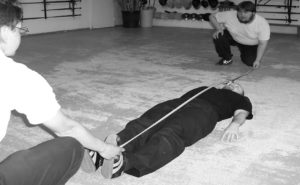
We then measured out the same length from the centre of the thrusting target to a point on the floor, and marked the distance off with tape.
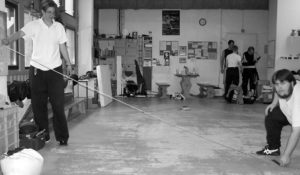
Standing on that mark, I placed my sword on the floor and lunged to its length (it has a 42″ blade).
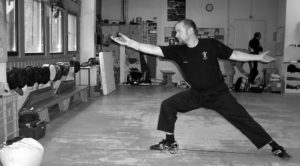
Recovering to guard, and rechecking the position of my left foot, I took up my sword and lunged at the target, following my interpretation of Capo Ferro's instructions, leaving out only the turn of the back foot (which had not been allowed for in the initial measurement). The point of my sword touched the target.

I then turned my back foot, and the sword bent: the increase in the distance was about 10cm, or 4″.
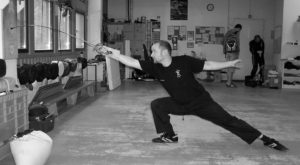
By leaving out the foot turn in the initial measurement, I ensured that the lunge would penetrate a realistic amount, not just touch.
I then marked the spot where the back of my front heel landed,
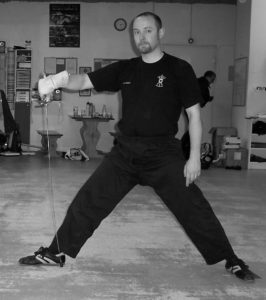
and withdrew my foot until the toes were a little behind the mark (Capoferro shows the place of the front foot in guard as being directly behind the foot in the lunge). This gave me an exact length for my passo.

I then established my guard position according to the instructions, and lunged again from this position, making sure that the extension came first, and when that was complete, my hips moved forward, my knee went over my toes, and my back foot turned all in the space of time my front foot was in motion. This gave me the longest anatomically possible lunge, with a front foot movement of only about 12 inches, the maximum possible exchange of measure for time.
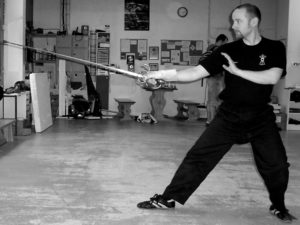

As a cross-check, I then measured the length of my lunge from front toes to back toes and found it to be about 57 inches, the length of my arm from armpit to fingertips to be 27 inches, so the length of my lunge was a trifle longer that twice the length of my arm.
Having done this myself, I then repeated the whole procedure for a small class of rapier students. Of course, with different length bodies and weapons, the maximum possible lunge was a different absolute length for each student. Out of six students, four men and two women, both women could reach their maximum lunge, and none of the men, primarily due to hip flexibility. However, none could easily recover, or felt comfortable in their maximum positions. More importantly, each student caught sight of an exact, measurable goal; to be able to lunge easily to the maximum distance, and recover fluidly to the correct guard position.
So, it is my belief that Capoferro describes the perfect lunge for his weapon. It is practically impossible to execute any kind of blade action with a full-size rapier while lunging, so Capoferro has us be able to strike from as far away as possible, in as short a time as possible. While your foot is in the air it is very hard to support your blade with strength, and so it is the ideal time for your opponent to counter; minimising the foot movement (by keeping it as far forwards as practically possible) while maintaining the maximum distance of your face from his point (by keeping your weight back) gives you the ideal tactical compromise. Of course, the sword still has a long way to go, but for most of that distance, you have both feet on the ground and can therefore execute blade actions more easily.
So, how do you train to achieve this ideal lunge? stretching, for flexibility, strength training for support and recovery, and going at it little by little. A short lunge that doesn't hurt you is much more useful than a long one that pulls a muscle. But by having an ideal to work towards, we can measure our progress towards an achievable goal.
With thanks to Kevin O'Brien (photographer), Heikki Hallamaa, and Karolina Suominen
